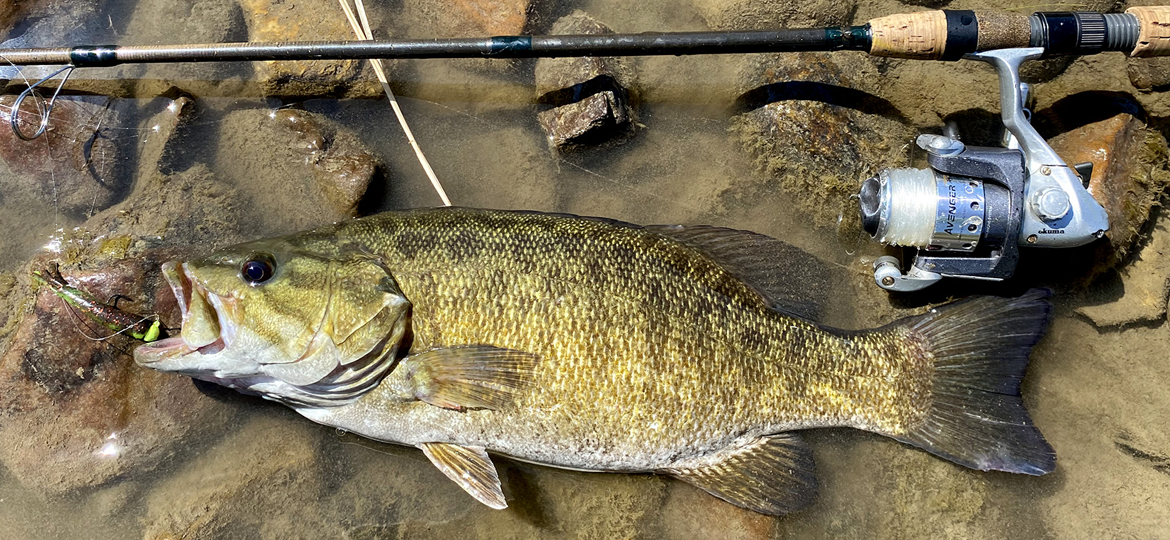
Smallmouth bass (Micropterus dolemieui) are a close relative to largemouth bass. Unlike their largemouth counterparts, smallmouth bass have an upper jaw that extends to the middle or posterior portion of the eye, but not beyond that point. Their elongated body and terminal, upturned jaw give them a distinguishable shape. Their greenish bronze to dark brown upper body fades into yellow-green sides where 8 to 11 vertical black bars are also noticeable. Younger individuals have a distinct yellow and black caudal fin edged in white.
Native from St. Lawrence, Champlain, and Hudson Bay drainages west through the Great Lakes basin and south to the Mississippi basin and into northern Alabama and Oklahoma, smallmouth bass have also been widely introduced outside of their native origin. They are common in the lakes and rivers of Vermont but are believed to be only native to the Champlain Valley.
Smallmouth bass are commonly 10 to 14 inches in length, but bass up to 20 inches (3 to 4 pounds) are also found.
Habitat
Smallmouth bass inhabit rocky or sandy areas of lakes and in pools of gravelly, moderate-gradient streams. They congregate around the cover of boulders and logs. While they are relatively tolerable to low pH, they are not commonly found in waters with pH below 5.5. Water temperatures up to 90°F are tolerable but 68 to 82°F is ideal.
Reproduction
Males will initiate nest building in sand or gravel, usually around stumps and boulders between the months of April and June as water temperatures reach around 55 to 73°F. Egg deposition and fertilization begins at temperatures around 61 to 65°F. Spawning takes place between a male and one or more females. Females contain 5,000-14,000 adhesive eggs that will sink into the nest and are guarded by the male for at least 4 to 10 days after spawning, until young bass are able to move away from the bed. Spawning can be interrupted if water temperatures drop below 60°F in which case males will abandon the nest, leaving eggs vulnerable to predators.
Males will become sexually mature in 3 to 5 years, while females mature around 1 to 2 years.
Diet
As adults, smallmouth bass are voracious predators that will feed on pretty much any food that will fit in their months. Some foods include frogs, tadpoles, newts, dragonflies, crayfish, and many kinds of fish. Feeding tends to occur more frequently at dawn and dusk.
Management
In most Vermont waters smallmouth bass are a popular sport fish managed under general fishing regulations. See current regulations for waterbody specific information.
The department’s Bass Management Team developed a statewide management plan for largemouth and smallmouth bass. The primary purposes of this plan are to:
- Assist department fisheries biologists with the implementation of sound and consistent management strategies for the protection or enhancement of bass populations and the recreational fisheries they support.
- Provide an educational resource for anglers, Fish and Wildlife Board members, legislators, media and the general public on a variety of bass fishery management issues.
Bass populations are periodically monitored during the late spring in waters throughout Vermont. Here is an example of these efforts:
Status
Smallmouth bass have been introduced to many waters throughout Vermont over the last century. Illegal introduction of smallmouth bass can threaten native fish populations.
Fun Facts
- Other common names: smallmouth, small-mouthed blackbass, northern small-mouth, brown bass, green bass, achigan á petite bouche.
- Smallmouth bass are a strong fighting fish prone to leaping from the water when hooked.
